Project
3. Work in groups. One group will think of advantages of online learning with virtual reality technology in classrooms. The other group will think of disadvantages of online learning with virtual reality technology in classrooms. Hold a debate in class on the issue.
(Làm việc nhóm. Một nhóm sẽ nghĩ về lợi ích của việc học trực tuyến với công nghệ thực tế ảo trong lớp học. Nhóm còn lại sẽ nêu nhược điểm của việc học trực tuyến với công nghệ thực tế ảo trong lớp học. Tổ chức một cuộc tranh luận trong lớp về vấn đề này.)
Advantages:
There are many advantages to online learning with virtual reality technology. First of all, it makes education more accessible to a wider range of students who may not have the opportunity to attend physical classrooms. It also provides an immersive learning experience that engages students and makes learning more fun. With virtual reality, students can explore complex and abstract concepts in a more visual and interactive way, which can lead to a deeper understanding of the material. Additionally, virtual reality technology can be used to simulate real-world scenarios, which can prepare students for careers and situations that they may encounter in the future. Finally, online learning with virtual reality technology allows for flexible and personalized learning experiences, which can accommodate the unique needs and learning styles of individual students.
(Lợi ích
Có rất nhiều lợi ích khi học trực tuyến với công nghệ thực tế ảo. Trước hết, nó làm cho giáo dục dễ tiếp cận hơn với nhiều học sinh hơn, những người có thể không có cơ hội tham dự các lớp học thực tế. Nó cũng cung cấp trải nghiệm học tập phong phú thu hút học sinh và làm cho việc học trở nên thú vị hơn. Với thực tế ảo, học sinh có thể khám phá các khái niệm phức tạp và trừu tượng theo cách tương tác và trực quan hơn, điều này có thể giúp hiểu sâu hơn về tài liệu. Ngoài ra, công nghệ thực tế ảo có thể được sử dụng để mô phỏng các tình huống trong thế giới thực, giúp học sinh chuẩn bị cho nghề nghiệp và các tình huống mà các em có thể gặp phải trong tương lai. Cuối cùng, học trực tuyến với công nghệ thực tế ảo cho phép trải nghiệm học tập linh hoạt và được cá nhân hóa, có thể đáp ứng nhu cầu và phong cách học tập riêng của từng học sinh.)
Disadvantages:
On the other hand, there are also potential disadvantages to consider when it comes to online learning with virtual reality technology. Not all students have equal access to technology and the internet, which could create a digital divide and exacerbate existing inequalities in education. Additionally, some students may find it difficult to learn in a completely virtual environment and may prefer face-to-face interaction with teachers and peers. Furthermore, prolonged exposure to virtual environments could lead to health risks such as headaches, nausea, and eye strain. It's important to carefully consider these potential drawbacks and find ways to address them in order to ensure that online learning with virtual reality technology is accessible, effective, and safe for all students.
(Bất lợi
Mặt khác, cũng có những nhược điểm tiềm ẩn cần xem xét khi học trực tuyến với công nghệ thực tế ảo. Không phải tất cả học sinh đều có quyền truy cập công nghệ và internet như nhau, điều này có thể tạo ra khoảng cách kỹ thuật số và làm trầm trọng thêm sự bất bình đẳng hiện có trong giáo dục. Ngoài ra, một số học sinh có thể cảm thấy khó học trong môi trường hoàn toàn ảo và có thể thích tương tác trực tiếp với giáo viên và bạn bè hơn. Hơn nữa, việc tiếp xúc lâu với môi trường ảo có thể dẫn đến các rủi ro về sức khỏe như đau đầu, buồn nôn và mỏi mắt. Điều quan trọng là phải xem xét cẩn thận những nhược điểm tiềm ẩn này và tìm cách giải quyết chúng nhằm đảm bảo rằng việc học trực tuyến với công nghệ thực tế ảo có thể truy cập, hiệu quả và an toàn cho tất cả học sinh.)

Các bài tập cùng chuyên đề
6 SPEAKING What traditions are there in schools in Viet Nam? Use the ideas below to help you.
(Có những truyền thống nào trong các trường học ở Việt Nam? Sử dụng những ý tưởng dưới đây để giúp bạn.)

In pairs: What is happening in the picture? Would you like to go to university in the future? Why (not)?
(Theo cặp: Những gì đang xảy ra trong bức tranh? Bạn có muốn học đại học trong tương lai không? Tại sao (không)?)

b. In pairs: Who do you know that studies at university? What, where, and how do they study? Would you like to study in the same way?
(Theo cặp: Bạn biết ai học ở trường đại học? Họ học cái gì, ở đâu và như thế nào? Bạn có muốn học theo cách tương tự không?)
My sister studies marketing in Hanoi. (Em gái tôi học marketing ở Hà Nội.)
Does she study online or in person? (Cô ấy học trực tuyến hay trực tiếp?)
e. In pairs: Do you think you'd enjoy studying the same course or in the same way as Emilly? Why (not)?
(Theo cặp: Bạn có nghĩ rằng bạn thích học cùng một khóa học hoặc theo cách giống như Emily không? Tại sao không)?)
c. In pairs: Ask and answer about the points below using the table above. Which course would you prefer? Why?
(Theo cặp: Hỏi và trả lời về các điểm dưới đây bằng cách sử dụng bảng trên. Bạn thích khóa học nào hơn? Tại sao?)

Does either course have afternoon classes? (Liệu một trong hai khóa học có các lớp học buổi chiều?)
Yes, both courses do. (Có, cả hai khóa học đều có).
a. In pairs: Practice the conversation. Swap roles and repeat.
(Theo cặp: Thực hành hội thoại. Trao đổi vai trò và lặp lại.)
Peter: Hi Jennifer. How can I help?
Jennifer: Hi Peter. I can't decide which university to study at. I really like both Weston and Eastdale.
Peter: OK. Let's have a look. What do you want to study?
Jennifer: I want to study marketing or economics.
Peter: Both universities teach marketing. Only Eastdale has economics. Would you like to study in person or online?
Jennifer: Oh. Can I study online?
Peter: Let's see... Yes, you can study online at either university.
Jennifer: OK. I think I'll study economics online at Eastdale.
Peter: Well, I'm glad I could help.
Jennifer: Me too! Thanks!
Tạm dịch:
Peter: Chào Jennifer. Tôi có thể giúp gì?
Jennifer: Chào Peter. Tôi không thể quyết định nên học trường đại học nào. Tôi thực sự thích cả Weston và Eastdale.
Peter: Được rồi. Chúng ta hãy có một cái nhìn. Bạn muốn học cái gì?
Jennifer: Tôi muốn học tiếp thị hoặc kinh tế.
Peter: Cả hai trường đại học đều dạy marketing. Chỉ Eastdale có kinh tế học. Bạn muốn học trực tiếp hay trực tuyến?
Jennifer: Ồ. Tôi có thể học trực tuyến không?
Peter: Để xem nào... Vâng, bạn có thể học trực tuyến tại một trong hai trường đại học.
Jenifer: Được rồi. Tôi nghĩ tôi sẽ học kinh tế trực tuyến tại Eastdale.
Peter: Chà, tôi rất vui vì tôi có thể giúp được.
Jennifer: Tôi cũng vậy! Cảm ơn!
b. Make two more conversations using the information in the tables. Decide on a university at the end.
(Thực hiện thêm hai cuộc hội thoại bằng cách sử dụng thông tin trong bảng. Quyết định về một trường đại học ở cuối.)

SELF-DRIVING TAXIS: WHICH UNIVERSITY SHOULD I CHOOSE? (NÊN CHỌN TRƯỜNG ĐẠI HỌC NÀO?)
a. A student is meeting their advisor to talk about universities. In pairs: Student B, advisor. Ask the student questions and explain the two options.
(Một sinh viên đang gặp cố vấn của họ để nói về các trường đại học. Theo cặp: Học sinh B, cố vấn. Đặt câu hỏi cho học sinh và giải thích hai lựa chọn.)
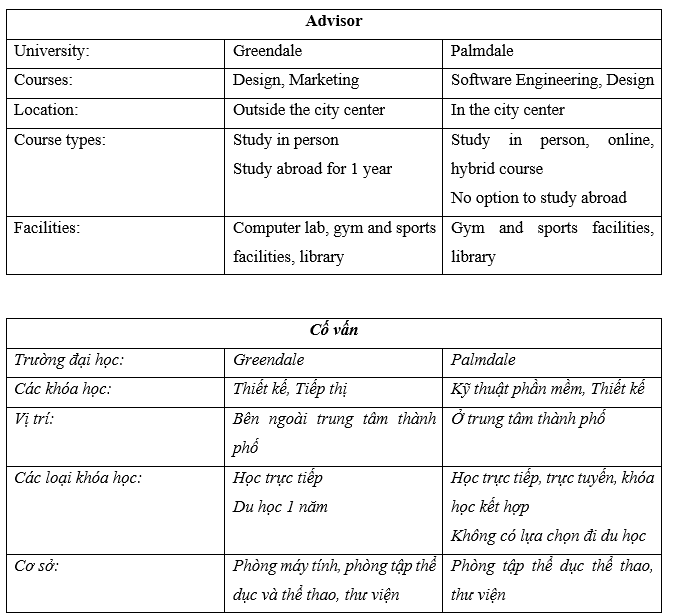
b. Swap roles and repeat. Student A, you're a student who wants to study either marketing or economics at Wakefield or Valleton University. Listen to Student B and decide which university to study at.
(Trao đổi vai trò và lặp lại. Sinh viên A, bạn là sinh viên muốn học tiếp thị hoặc kinh tế tại Đại học Wakefield hoặc Valleton. Lắng nghe sinh viên B và quyết định học trường đại học nào.)
c. What do you think are the most important things about a university? Join another pair. Do you agree?
(Bạn nghĩ những điều quan trọng nhất về một trường đại học là gì? Tham gia một cặp khác. Bạn có đồng ý không?)
In pairs: What is happening in the picture? Do you like using technology at school? Why (not)?
(Làm theo cặp: Những gì đang xảy ra trong bức tranh? Bạn có thích sử dụng công nghệ ở trường không? Tại sao (không)?)

b. In pairs: Talk about how and when people use smart devices. What do you like to do on a smart device? Why?
(heo cặp: Nói về cách thức và thời điểm mọi người sử dụng các thiết bị thông minh. Bạn thích làm gì trên một thiết bị thông minh? Tại sao?)
My mom uses social media with her tablet. (Mẹ tôi sử dụng mạng xã hội với máy tính bảng của bà.)
I charge my smartphone at night. (Tôi sạc điện thoại thông minh của mình vào ban đêm.)
a. You're a student at Smartschool. Take turns to describe your school's rules to a partner.
(Bạn đang là học sinh tại Smartschool. Thay phiên nhau mô tả các quy tắc của trường bạn cho một đối tác.)
We have to wear school uniforms. (Chúng tôi phải mặc đồng phục học sinh.)
And we can't stay inside at break time. (Và chúng ooia không thể ở trong nhà vào giờ giải lao.)
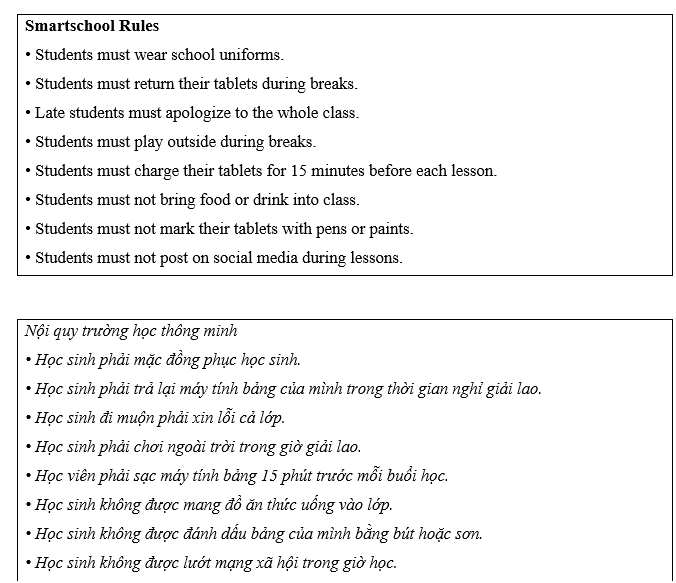
b. Use your own ideas to suggest new rules or changes to these rules.
(Sử dụng ý tưởng của riêng bạn để đề xuất các quy tắc mới hoặc thay đổi các quy tắc này.)
We shouldn't have to go outside at break time.
(Chúng ta không cần phải ra ngoài vào giờ giải lao.)
TECHNOLOGY CLUB MEETING: SOLVING PROBLEMS AT SCHOOL
(Họp CLB công nghệ: giải vấn đề trong trường học)
a. Imagine your school introduced tablets for everyone but there are some problems. In pairs: Discuss and write rules to solve each problem.
(Hãy tưởng tượng trường học của bạn giới thiệu máy tính bảng cho mọi người nhưng có một số vấn đề. Theo cặp: Thảo luận và viết quy tắc để giải từng bài toán.)
I think students shouldn't be allowed to take the tablets home.
(Tôi nghĩ học sinh không nên được phép mang máy tính bảng về nhà.)
You're right. Let's make a new rule: Students must return their tablets at the end of the day.
(Bạn đúng. Hãy đưa ra một quy tắc mới: Học sinh phải trả lại máy tính bảng của mình vào cuối ngày.)
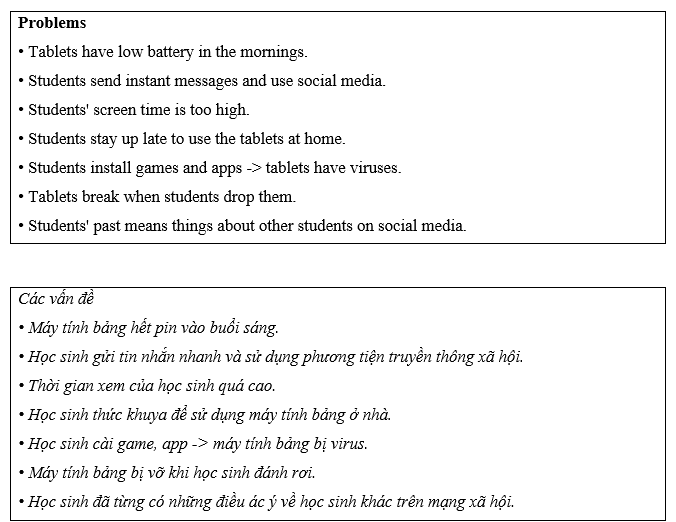
b. Share your rules with another pair. Which rules will help students the most? Why?
(Chia sẻ quy tắc của bạn với một cặp khác. Quy tắc nào sẽ giúp học sinh nhiều nhất? Tại sao?)
Now, students have to return their tablet before they go home. This will reduce their screen time and stop them staying up too late.
(Giờ đây, học sinh phải trả lại máy tính bảng trước khi về nhà. Điều này sẽ giảm thời gian sử dụng thiết bị của họ và ngăn họ thức quá khuya.)
In pairs: What career do you think the boy in the photo wants in the future? What do you think he needs to do to get that job?
(Làm theo cặp: Bạn nghĩ cậu bé trong ảnh muốn làm nghề gì trong tương lai? Bạn nghĩ cậu ấy cần phải làm gì để có được công việc đó?
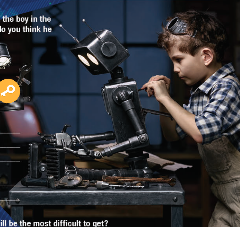
c. In pairs: Which of the things Chris needs do you think will be the most difficult to get?
(Theo cặp: Bạn nghĩ thứ nào mà Chris cần sẽ khó đạt được nhất?)
d. In pairs: What job do you want in the future? Do you need the same degree, skills, or experience as Ben?
(Theo cặp: Bạn muốn làm công việc gì trong tương lai? Bạn có cần bằng cấp, kỹ năng hoặc kinh nghiệm như Ben không?)
a. With a partner, discuss your dream jobs. Say what degree, skills and experience you need, and how to get them.
(Với một đối tác, thảo luận về công việc mơ ước của bạn. Cho biết bạn cần bằng cấp, kỹ năng và kinh nghiệm nào, và làm thế nào để có được chúng.)
I want to be an English teacher. (Tôi muốn trở thành một giáo viên tiếng Anh.)
I need a university degree. (Tôi cần bằng đại học.)
I plan to study at a university near my hometown. (Tôi dự định học tại một trường đại học gần quê hương của tôi.)
b. Complete the table with your three most important needs and reasons why, then add solutions.
(Hoàn thành bảng với ba nhu cầu quan trọng nhất của bạn và lý do tại sao, sau đó thêm các giải pháp.)

b) Think Which of the underlined phrases / sentences are used for making predictions? responding? Think of more similar phrases / sentences?
(Những cụm từ / câu được gạch chân nào được sử dụng để đưa ra dự đoán? phản hồi? Hãy nghĩ thêm những cụm từ / câu tương tự?)
4 Act out a dialogue similar to the one in Exercise 3a. Use the diagram below. Mind the intonation and rhythm.
(Diễn một đoạn đối thoại tương tự như đoạn trong Bài tập 3a. Sử dụng sơ đồ dưới đây. Nhớ ngữ điệu và nhịp điệu.)
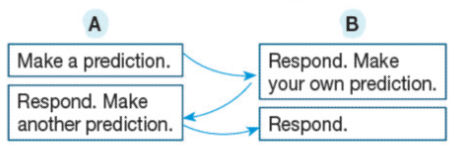
1 Read the title and look at the picture. What do you think the text is about? Listen / Watch and read to find out.
(Đọc tiêu đề và nhìn vào hình ảnh. Bạn nghĩ văn bản nói về điều gì? Nghe / Xem và đọc để tìm hiểu.)
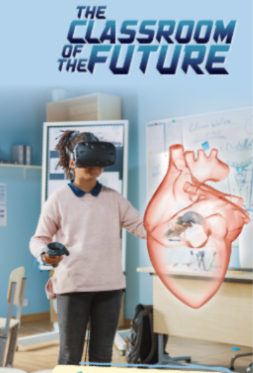
The development of technology has opened up a whole new world of possibilities for us. Thanks to the Internet, it is now possible to learn remotely with online courses, but some schools in Vietnam are going one step further to make learning more interesting. By using 3D technology and visual reality technology, Vietnamese schools are creating a whole new kind of classroom experience.
Back in 2013, a high school in Ho Chi Minh City became the first Vietnamese school to use 3D technology in the classroom. The teachers there used this technology to teach science subjects. They created amazing 3D models, such as a human heart model, to help students get a clearer understanding of what they were learning in class. This was an amazing new development in teaching as this 3D technology allowed teachers to explain difficult information to students in an interesting way.
In 2019, moreover, there was another major development when a university in Hanoi began offering virtual reality technology (VR) trial classes to people who were interested in studying there. The university has used 360-degree virtual reality technology to allow people in other parts of Vietnam to experience all of the sights and sounds of learning in a real classroom.
By combining 3D and virtual reality technology, today's schools are creating an interesting learning experience in which anyone can participate. It's exciting to think that every school in the world might be using virtual classrooms in the near future!
• remotely
• 3D technology
virtual reality technology
• model
• trial
3. PROJECT How will students in the future learn?
(DỰ ÁN Học sinh trong tương lai sẽ học như thế nào?)
Work in groups. Imagine you will observe a classroom in 2070.
(Làm việc nhóm. Hãy tưởng tượng bạn sẽ quan sát một lớp học vào năm 2070.)
3. Complete the dialogue with the phrases in the list.
(Hoàn thành cuộc đối thoại với các cụm từ trong danh sách.)

A: I'm writing an essay about the future of education. I predict that teachers will use virtual reality devices in digital classrooms.
B: 1) ____________ will happen. There is a good chance students will use 3D digi books and hologram devices in the classroom, but I think 2) ____________. Nothing else.
A: I don't 3) ____________. I bet students will use cyborg guides and present all the subjects digitally.
B: Not sure, but 4) ____________.






